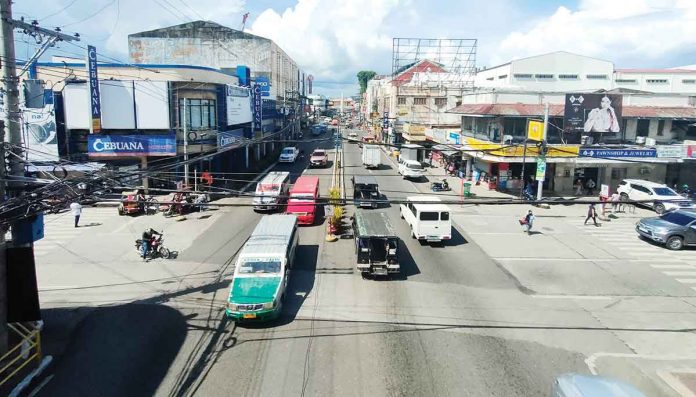
ILOILO City – Are there enough modern and traditional jeepneys to haul provincial passengers from transport terminals to the city when the Local Public Transport Route Plan (LPTRP) would be implemented beginning June 12?
Yes there are enough, according to the Western Visayas Transport Cooperative (WVTC) which operates modern jeepneys and still have member-operators with traditional jeepneys.
LPTRP prohibits provincial jeepneys from entering the city. They are only up to the transport terminals located in the city’s border barangays. Taking city-bound provincial passengers from the transport terminals to the city would solely be the task of city loop jeepneys.
According to Raymundo Parcon, WVTC president, members have been meeting almost every day in preparation for the LPTRP implementations two weeks from now.
WVTC is composed 17 city-based transport associations. Parcon said they have sufficient number of jeepneys to move city-bound people from the transport terminals, and even serve new city routes that LPTRP will open beginning June 12.
There are 13 new routes that would be serviced by 553 authorized units, said Parcon. These are the following:
* Ungka – Iloilo City via Diversion / Festive Walk Transport Hub Loop (26 units)
* Ungka – Iloilo City Proper via CPU (55 units)
* Calaparan Calumpang – Iloilo Proper (40 units)
* Festive Walk Transport Hub – Iloilo City Proper via SM City (69 units)
* Villa Baybay to Iloilo City Proper via Bonifacio (25 units)
* Molo – Iloilo City Proper via Baluarte Loop (nine units)
* Hibao-an-Iloilo City Proper via Tabucan / Festive Walk Transport Hub (38 units)
* Mandurriao – Molo via Festive Walk Transport Hub Loop (20 units)
* La Paz – Iloilo City Proper via ISAT-U (63 units)
* Tagbak – Iloilo City Proper (68 units)
* Mohon – Infante Loop (39 units)
* Compania – Iloilo City Proper Loop (21 units)
* Lanit – SM City via NIA/Jalandoni (80 units)
Parcon said modernized and traditional jeepneys of their cooperative would be mobilized until all their ordered modernized jeepneys would have been delivered. Only then would the traditional jeepneys be permanently decommissioned, he stressed.
WVTC ordered a total of 600 units of modernized jeepneys. Parcon said there were delays in their bank loan.
“Sa gin-approve sang Land Transportation Franchising and Regulatory Board (LTFRB) for the LTPRP, may ara kita nagabyahe 24 hours nga mga units,” said Parcon.
WVTC is also coordinating with the city government’s Public Safety and Transportation Management Office (PSTMO) head Jeck Conlu on the clearing of the city’s major thoroughfares for the smooth operation of modernized jeepneys that are bigger and longer than traditional jeepneys.
Aside from WVTC, four other transport cooperatives were authorized by LTFRB to operate modern jeepneys.
One of them is the Iloilo City Alliance of Operators and Drivers Transport Cooperative (ICAODTC).
As for the transport terminals, the five major ones here have lots of deficiencies that must be fixed in time for the implementation of the LTPRP. They risk losing their franchises to operate if they won’t.
LTFRB Region 6 recently inspected these terminals located in the city’s border barangays of Ungka and Tagbak (Jaro district), Villa-Mohon (Arevalo district), Hibao-an (Mandurriao district), and Baldoza (La Paz district).
“Generally indi sila passing, damu kakulangan gid,” said Atty. Jun Altura, the LTFRB-6 legal counsel.
Among these deficiencies were the transport terminals’ unpaved parking areas, cramped or limited parking spaces and insufficient benches for waiting passengers, said Altura.
Transport terminals are required to be in sync with the government’s transport modernization program, which means they must be able to accommodate modernized jeepneys which are decidedly heftier in height, width and length than traditional jeepneys, stressed Altura.
In Memorandum Circular 2008-013, transport terminals are also required to have the following:
* roofing that would provide sufficient shade to passengers from the heat of the sun or rain
* wide entrances and exits for easy mobility to and from the terminal
* communication facilities (telephone, fax machine, internet, etc.)
* public address system and security cameras
* information and passenger assistance counters
* appropriate and adequate signage
* sufficient number of security personnel
* separate restrooms for males, females and persons with disabilities that at all times must be clean, sufficiently lighted, well-ventilated, with running water, flush system, toilet seat with cover and lavatory, waste bin, toilet paper, mirror, dispenser with soap, hand dryer, and functional door lock
* priority lane for persons with special needs (pregnant women, persons with disabilities, mothers travelling with small children)/PN



